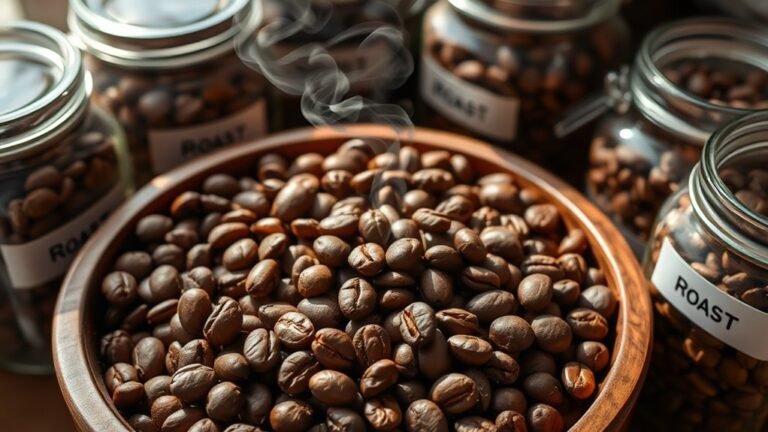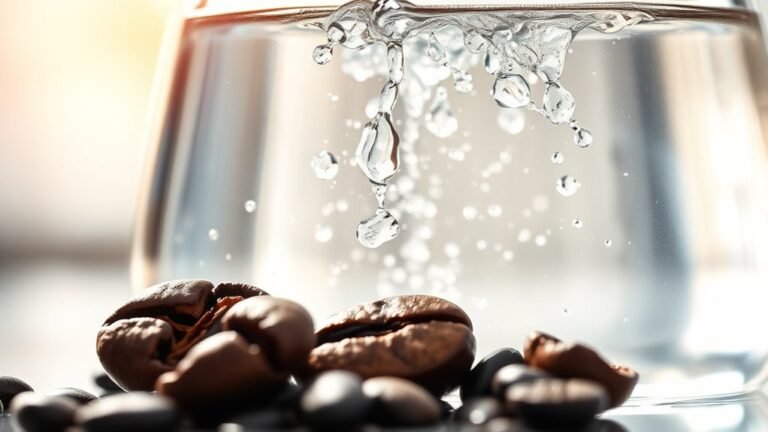The Best Coffee for a Kalita Wave
For the Kalita Wave, you’ll want freshly roasted, single-origin beans with a light to medium roast to highlight clarity and nuanced flavors. Ethiopian or Guatemalan origins work well, offering distinct acidity and sweetness that suit its flat-bottom, three-hole design. Use a consistent medium-coarse grind and maintain precise water temperature between 195°F and 205°F for best extraction. Dark roasts may mask subtle notes, so they’re less ideal. Keep these factors in mind to refine your brew further.
Understanding the Kalita Wave Brewing Method

Although the Kalita Wave may look simple, its unique flat-bottom design with three small holes requires precise control over grind size, water temperature, and pour rate to optimize extraction and flavor clarity. When you use this brewer, mastering specific brewing techniques is essential. You’ll want a medium-coarse grind to balance flow rate and extraction uniformity. Water temperature should ideally stay between 195°F and 205°F to dissolve desirable compounds without over-extraction. Your pour rate must be steady and deliberate, allowing the flat bottom and three holes to create consistent pressure and even saturation. These extraction methods yield a clean, balanced cup that highlights nuanced flavors. By honing these variables, you gain freedom to tailor your brew, pushing the Kalita Wave beyond simplicity into precision brewing artistry.
Importance of Bean Origin for Kalita Wave
Since the Kalita Wave emphasizes clarity and balance, selecting coffee beans with a well-defined origin is essential to fully appreciate its brewing capabilities. The origin flavors and terroir impact are distinctly highlighted, allowing you to experience nuanced acidity, sweetness, and body. Understanding bean origin helps you predict how these characteristics will manifest through the Kalita’s flat-bottomed design and consistent extraction.
| Region | Typical Origin Flavors | Terroir Impact |
|---|---|---|
| Ethiopia | Floral, Citrus, Tea-like | High altitude, volcanic soil |
| Colombia | Caramel, Nutty, Balanced | Volcanic soil, consistent rain |
| Kenya | Berry, Bright Acidity | Volcanic soil, high elevation |
| Guatemala | Cocoa, Spicy, Complex | Volcanic soil, microclimates |
Choosing beans with clear origin profiles lets you reveal the Kalita Wave’s full freedom in flavor expression.
Light Roasts That Shine With Kalita Wave
When you brew light roasts with the Kalita Wave, you reveal intricate acidity and delicate floral notes that darker roasts often mask. Light roast characteristics include higher acidity, nuanced fruity and floral profiles, and a lighter body. To fully express these traits, you must carefully control brewing temperature impacts; a range between 195°F to 205°F optimizes extraction without over-extracting bitter compounds. The Kalita Wave’s flat-bottom design supports even saturation, which is critical for highlighting the subtle complexities of light roasts. By adjusting grind size and pour rate, you gain precise control over extraction time, allowing the coffee’s brightness and clarity to shine. Embracing these parameters lets you unveil the full spectrum of flavors light roasts offer, granting you freedom to tailor each cup’s vibrancy.
Medium Roasts Ideal for Balanced Flavor

Light roasts highlight brightness and acidity, but medium roasts offer a more balanced flavor profile that combines acidity with sweetness and a fuller body. When using a Kalita Wave, medium roast characteristics like caramelized sugars and moderate acidity shine through, providing a well-rounded cup. You’ll want to fine-tune your brewing temperature—typically between 195°F and 205°F—to optimize extraction. Lower temperatures may under-extract, muting sweetness, while higher temperatures risk over-extraction, introducing bitterness. The Kalita’s flat-bottom filter guarantees even saturation, highlighting these medium roast nuances. By controlling grind size and pour rate alongside temperature, you can reveal complex flavors that maintain clarity without overpowering bitterness. This balance allows you the freedom to experiment and craft a cup that suits your palate precisely.
Dark Roasts and Their Compatibility
Although dark roasts typically emphasize bold, smoky flavors and reduced acidity, their compatibility with the Kalita Wave requires careful adjustments to brewing variables. You’ll want to optimize grind size, water temperature, and brew time to extract the dark roast benefits without overwhelming bitterness. The Kalita Wave’s flat-bottom filter promotes even extraction, essential when working with the denser, oilier beans of dark roasts. Mastering specific brewing techniques lets you reveal nuanced flavor profiles while maintaining balance.
| Variable | Recommended Adjustment |
|---|---|
| Grind Size | Slightly coarser than medium roast |
| Water Temp | 90–94°C (194–201°F) |
| Brew Time | 2.5–3.5 minutes |
| Pour Technique | Slow, circular pour for uniformity |
Adjusting these parameters lets you enjoy dark roasts with clarity and depth using the Kalita Wave.
Single-Origin Coffees to Try With Kalita Wave
Because the Kalita Wave excels at highlighting clarity and complexity, single-origin coffees are an ideal choice to showcase distinct regional characteristics. When you select single origin varieties, you reveal precise tasting notes unique to each growing region. For example, Ethiopian Yirgacheffe delivers bright citrus and floral accents, while Guatemalan Huehuetenango offers a balanced profile with chocolate and berry undertones. Brewing these coffees with the Kalita Wave’s flat-bottomed dripper and consistent extraction technique guarantees you capture nuanced acidity and sweetness without muddiness. You’ll appreciate how the device’s controlled flow rate reveals every detail in the cup. Opt for light to medium roasts to maximize transparency in your tasting notes, granting you the freedom to explore and appreciate the intricate layers each single-origin variety presents.
Blends That Complement Kalita Wave Brewing

When selecting blends for your Kalita Wave, focus on those with balanced acidity and sweetness to maximize the brewer’s clarity. Medium roast levels often highlight the layered flavor profiles without overpowering the clean extraction. You’ll want to experiment with blends that combine fruity and nutty notes to complement the Kalita’s consistent flow rate.
Flavor Profiles to Explore
While the Kalita Wave’s flat-bottom design guarantees an even extraction, selecting the right blend can greatly enhance the cup’s complexity and balance. You’ll want to focus on coffee with nuanced flavor notes that reveal themselves through precise brewing. Explore blends featuring citrus acidity paired with subtle floral undertones to reveal bright, vibrant tasting profiles. Alternatively, blends with rich caramel and nutty elements offer a smooth, rounded experience when brewed with the Kalita Wave’s steady flow. Because the Wave accentuates clarity, you can identify layered sweetness and subtle fruit complexities more distinctly. Experimenting with blends that balance acidity, sweetness, and body allows you to tailor each cup to your preference, maximizing the unique interaction between the Kalita Wave and your chosen coffee’s tasting profiles.
Roast Levels for Kalita
Although the Kalita Wave excels at highlighting clarity and balance, selecting the ideal roast level is crucial for revealing its full potential. You’ll find that light roast nuances—such as bright acidity and complex floral or fruity notes—are amplified by the Wave’s flat-bottomed design and three-hole pour, which promote even extraction. Conversely, medium roast characteristics offer a sweet, caramelized profile with moderate acidity and fuller body, complementing the Kalita Wave’s precision by balancing brightness and depth. Avoid dark roasts, as they can obscure subtle flavors the Kalita adeptly extracts. When choosing blends, prioritize those with consistent roast profiles to guarantee uniform particle size and extraction. By tailoring your roast level choice, you gain freedom to craft a cup that highlights the Kalita Wave’s technical strengths, whether emphasizing vibrancy or richness.
Freshness and Grind Size Considerations

Since the Kalita Wave relies on a consistent extraction process, using freshly roasted coffee beans is essential to preserve volatile aromatic compounds and confirm ideal flavor clarity. You’ll want to focus on optimal bean storage—airtight, opaque containers kept in a cool, stable environment—to minimize oxidation and staling. Equally critical is grind consistency; the Kalita Wave’s flat-bottom design demands a uniform grind size to prevent channeling and uneven extraction. Aim for a medium-coarse grind, similar to sea salt, to balance flow rate and extraction time precisely. Investing in a quality burr grinder guarantees reproducible particle size distribution, empowering you to fine-tune your brew strength and flavor profile with confidence. Maintaining these parameters lets you access the Kalita Wave’s full potential, granting you freedom to explore nuanced coffee expressions.
Where to Buy Quality Coffee Beans for Kalita Wave
You’ll want to source your Kalita Wave coffee beans from specialty coffee retailers who prioritize single-origin, freshly roasted beans with clear roast dates. Online bean marketplaces also offer extensive selections, allowing you to compare flavor profiles and roast levels precisely. Both options guarantee you can control quality factors critical for ideal extraction and flavor clarity in your Kalita Wave brew.
Specialty Coffee Retailers
When selecting coffee beans for your Kalita Wave, sourcing them from specialty coffee retailers guarantees prime freshness and flavor complexity. These retailers often collaborate directly with specialty roasters who emphasize single-origin beans, meticulous processing, and precise roast profiles tailored for pour-over methods. Opting for beans from such sources guarantees peak acidity, balance, and nuanced flavor notes that the Kalita Wave highlights. Additionally, many specialty roasters offer curated coffee subscriptions, providing you with consistent access to freshly roasted, seasonal varieties delivered at peak maturity. This approach not only preserves the coffee’s volatile aromatics but also grants you the freedom to experiment with diverse flavor profiles without compromising quality. By prioritizing specialty coffee retailers, you maintain control over your brewing experience while enjoying superior bean integrity every time.
Online Bean Marketplaces
Anyone looking to source quality coffee beans for the Kalita Wave should consider online bean marketplaces, which offer extensive selections from various roasters worldwide. These platforms enable you to filter beans by origin, roast profile, processing method, and flavor notes, allowing precise alignment with your brewing preferences. Many online marketplaces provide detailed bean provenance and roast date information, ensuring freshness critical for the Kalita Wave’s extraction method. Additionally, coffee subscriptions available through these sites afford you the freedom to explore diverse single-origin and specialty blends delivered regularly, optimizing your supply without hassle. By leveraging online marketplaces, you gain access to curated selections typically unavailable locally, empowering you to experiment and refine your Kalita Wave experience with unparalleled convenience and control.
Frequently Asked Questions
How Does Water Temperature Affect Kalita Wave Brewing?
Water temperature is essential for ideal brewing with the Kalita Wave, directly influencing extraction yields. If your water’s too hot, you risk over-extracting, causing bitterness. Too cool, and you’ll under-extract, leaving your coffee weak and sour. Aim for 195-205°F to balance solubility and flavor release. Adjusting temperature lets you control extraction precision, giving you freedom to highlight preferred notes and tailor your brew exactly how you like it.
Can I Use Pre-Ground Coffee With the Kalita Wave?
Imagine Sarah, who loves convenience but craves quality. You can use pre-ground coffee with your Kalita Wave, but keep in mind the grind size is essential. Pre-ground benefits include saving time and consistency, yet often the grind is too fine or coarse for the Wave’s flat-bottom filter. To maintain clarity and balance, choose a medium-coarse grind or grind fresh if possible, ensuring ideal extraction and freedom in your brew experience.
What Is the Ideal Brew Ratio for Kalita Wave Coffee?
You’ll want to start with a brew ratio of about 1:16—meaning one gram of coffee per 16 grams of water—for balanced brew strength in your Kalita Wave. Adjust this to taste: increase coffee dose for a stronger cup, or use a coarser grind to slow extraction and reduce bitterness. Precision in grind size and ratio lets you customize the flavor freely, so experiment within 1:15 to 1:17 to find your ideal strength.
How Do Different Filter Types Impact Kalita Wave Coffee Taste?
Choosing your filter material is like selecting a lens through which your coffee’s flavor profile is viewed. Paper filters tend to absorb oils, producing a cleaner, brighter cup, while metal filters allow more oils and fines through, resulting in a fuller body and richer taste. Cloth filters balance clarity and texture, preserving nuanced flavors. Understanding how each filter material interacts with your brew lets you tailor the Kalita Wave experience to your taste freedom.
Is Kalita Wave Suitable for Cold Brew Coffee Methods?
You might wonder about the cold brew compatibility of the Kalita Wave. While it’s designed for pour-over, you can adapt it for cold brew by using coarser grounds and extending the steeping time, but this isn’t its primary strength. The Kalita Wave advantages lie in precise water flow and extraction control, ideal for hot brewing. For authentic cold brew, other methods like immersion are more efficient, granting you true freedom in flavor extraction.






